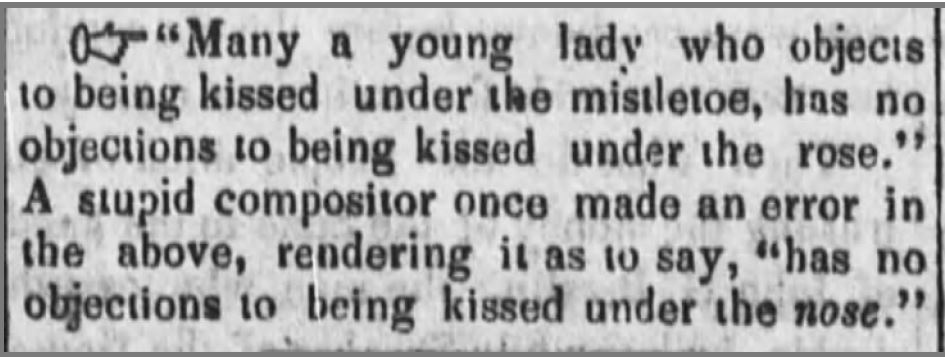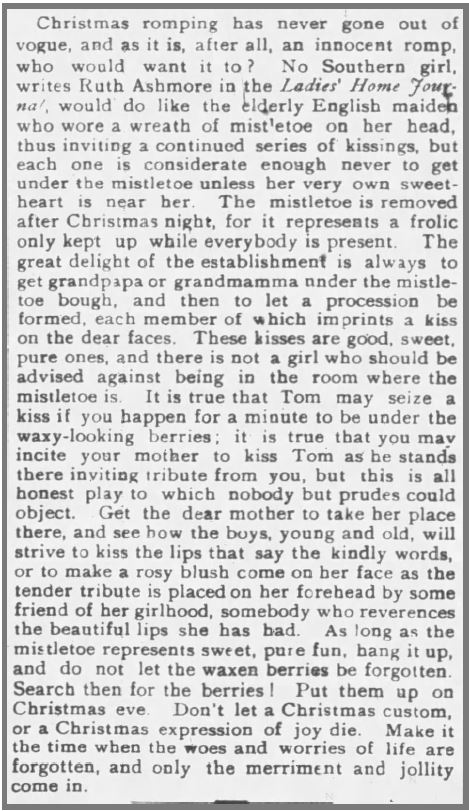The Ghost Story of Mistletoe
The ancient roots of mistletoe have nothing on the 19th century popularity of mistletoe. It was, for all intents and purposes, a great fad of Christmas.
It began with a poem, as many things popular with Christmas of the 19th century did. It was 1823 in a book titled “Italy” by Samuel Rogers. The poem was titled “Ginevra”.
 The poem tells the horrific story of a young bride who got married at Christmas-time to a man named Lord Lovell.
The poem tells the horrific story of a young bride who got married at Christmas-time to a man named Lord Lovell.
In a game of hide-and-seek held at the reception, the bride took off still in her dress – never to be seen again.
For hours, children and adults alike searched for the bride, but she was not to be found.
Before long the hours grew late and people started to leave. Long after the party had dispersed the bride’s father, her new husband and all the servants continued to search for her.
They could not find her.
Thinking perhaps she had fallen asleep somewhere, they too went to bed. When the bride did not re-appear the next morning the search began anew. The next day they did the same — and the next.
The days turned into weeks, the weeks into months and the months into years. Lord Lovell grew old without ever knowing the fate of his bride.
The story of her disappearance grew legendary round about. There were tales of her running off, fearful of having made a mistake in her new marriage.
In time the house was sold and the attic was emptied of its contents of old art and furniture. Found among the worthless treasures was an old chest, hopelessly locked.
After some difficulty the lid was finally opened and there inside, still in her wedding dress and holding the bridal bouquet, was the skeleton of the missing bride.
In hiding from her guests the lid had slammed shut, locking her inside.
The poem, retold around countless Christmas firesides as a ghost story, was made wildly popular by a song titled “The Mistletoe Bough”. It was written by T.H. Bayley and Sir Henry Bishop.
The song not only proved popular but also widespread.
In 1859, its ‘solemn chanting’ was referred to as a ‘national occurrence at Christmas’ in English households, and by 1862 the song was referred to as ‘one of the most popular songs ever written’, ‘which must be known by heart by many readers’.
The legendary tale, said to be based on a true story, has been claimed by many old houses in England as the place of its occurrence. Some of these houses claim to be still be haunted by the skeleton in the bride’s dress – who comes out at Christmastime to terrify those who still search for her.
The story told in the poem and made legend by the popular song of the 1830s spread around the world.
By the 1840s, with Christmas on the rise thanks to A Christmas Carol by Charles Dickens, A Visit from St. Nicholas by Clement C. Moore, and other rising elements of the Christmas tree and Christmas cards, telling of this and other ghost stories quickly became a holiday fad. Mistletoe became an icon of the season, often mentioned in the media of the 19th century:

Anciently tied to Druid religious celebrations surrounding the Winter Solstice mistletoe was said to have properties of fertility.
In one telling of legend from Scandinavian mythology a god of darkness shot his rival, the immortal Apollo of the North, with an arrow. Apollo fell to the ground, apparently dead.
But he fell beneath a berried bough of mistletoe, which revived him, making mistletoe a symbol of love, and not of death, to those who passed beneath it.
By tradition, “kissing” under the mistletoe and being given a berry from the sprig of mistletoe means a girl is destined to become married in the year ahead.
 Mistletoe was so popular as a Christmas party game that publications took to advising young ladies on the proper etiquette of responding while under the mistletoe. Girls were told not to be to prudes, according to the Ladies Home Journal in 1888, because a kiss under the mistletoe was “pure”.
Mistletoe was so popular as a Christmas party game that publications took to advising young ladies on the proper etiquette of responding while under the mistletoe. Girls were told not to be to prudes, according to the Ladies Home Journal in 1888, because a kiss under the mistletoe was “pure”.
In time, like live action plays of Dicken’s A Christmas Carol, the Mistletoe Bough was created in to skits and stage plays that proved popular during the Christmas season.
Whatever the source, few things were as popular at Christmas parties in the 19th century than mistletoe. Kissing was not a bad sport either.





Very interesting! I had never actually heard the story about the hide-and-seek bride!
Me neither. It’s a horrific story to of have been thought of and passed along. It sounds more of a tale to be told around a campfire or Halloween.
Remind me to never play hide and seek in old chests in the attic!
[QUOTE=”xmastidings, post: 1248633, member: 6758″]
Me neither. It’s a horrific story to of have been thought of and passed along. It sounds more of a tale to be told around a campfire or Halloween.
Remind me to never play hide and seek in old chests in the attic!
[/QUOTE]
You can hear the song in the latest podcast. I think we understand better now when they sing:
There’ll be parties for hosting
Marshmallows for toasting
And caroling out in the snow
There’ll be scary ghost stories
And tales of the glories of
Christmases long, long ago
[QUOTE=”Jeff Westover, post: 1248635, member: 1″]
You can hear the song in the latest podcast. I think we understand better now when they sing:
There’ll be parties for hosting
Marshmallows for toasting
And caroling out in the snow
There’ll be scary ghost stories
And tales of the glories of
Christmases long, long ago
[/QUOTE]
Also refers to that little ghost story Mr. Dickens wrote.
[QUOTE=”Jeff Westover, post: 1248635, member: 1″]
You can hear the song in the latest podcast. I think we understand better now when they sing:
There’ll be parties for hosting
Marshmallows for toasting
And caroling out in the snow
There’ll be scary ghost stories
And tales of the glories of
Christmases long, long ago
[/QUOTE]
Lol, yea, I’d say! It does kinda come altogether doesn’t.
I actually found the song that you posted, the melody of it was beautifully done. Love her singing voice.
Yes, I found several renditions. I liked hers because it was simple…and haunting
[MEDIA=youtube]VnrHeF3NhCs[/MEDIA]
Hopefully, the above is a link to the version by Kate Rusbyfrom her album Holy Head